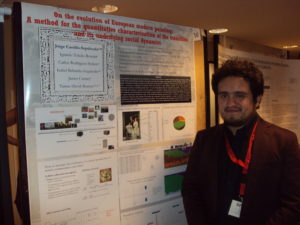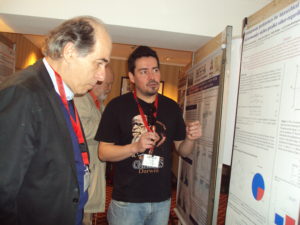The third day of ISHE was marked by the DCCS students’ presentations, Mauricio Aspé, Oriana Figueroa and Jorge Castillo who, during the afternoon, shared their research with the audience in a relaxed atmosphere. Their posters presentations are normally used to gain experience prior to a talk, also in case the investigation is inconclusive and, to share face-to-face with the guests and clarify doubts in a personalized way.
Jorge Castillo, a student from the DCCS first generation (2014), presented On the evolution of European modern printing: a method for the quantitative characterization of the transition and its underlying social dynamics. In his research, Castillo quantitatively characterized the transition in motives and content of modern European painting art during 1848 and 1938 using structural topic modeling on 167 artist biographies and image content analysis on 501 paintings produced by these artists. The results obtained through the use of Data Science pointed to an analogy around the transitions in culture of a given community together with the underlying changes in the social organization of the members of such community.
Mauricio Aspé focused on researching the Endogenous preferences for hierarchical versus horizontal economics niches predict others-regarding behaviours. Aspé begun his research by ensuring that “altruism and reciprocity are fundamental to understanding human behavior”, which is influenced by the institutional context, understood by the set of explicit and implicit incentives under which individuals behave. In this work, individuals were presented with two alternative social niches, where their rewards differ around the effort invested by them or by another. The hypothesized was the activity in the medial prefrontal cortex of the subjects, correlates with the way in which the subjects assess not only their own effort, but the other’s.
In the same way, Oriana Figueroa, belonging to the 2017 Generation, made an interesting and entertaining analogy in True Love and Other Options, Sociosexuality and attachment in Sex and The City, to elucidate about the search, selection and retention of a mating partner, which presents biologically differentiated challenges for each sex. Based on the characters of the series Sex and the City, real people’s reactions and preferences for the various mating strategies were analyzed. After her research, having a sample of 656 Spanish university students, Figueroa concludes, among other things, that early experiences affect the mating strategies deployed in adulthood.



